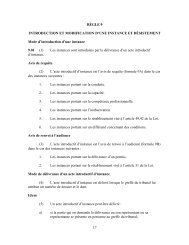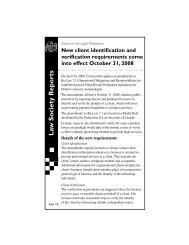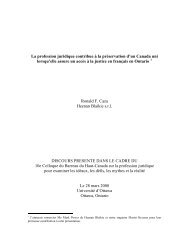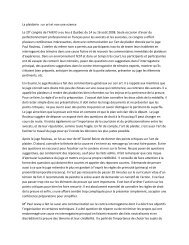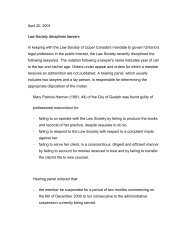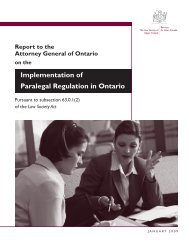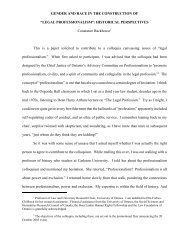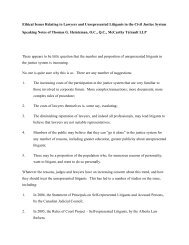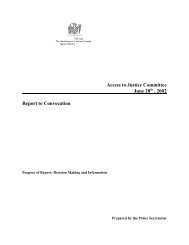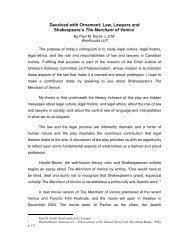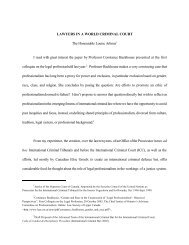of self regulation? - The Law Society of Upper Canada
of self regulation? - The Law Society of Upper Canada
of self regulation? - The Law Society of Upper Canada
Create successful ePaper yourself
Turn your PDF publications into a flip-book with our unique Google optimized e-Paper software.
model <strong>of</strong> <strong>regulation</strong>, is much too blunt an instrument to effectively and efficiently get<br />
results; 170 the only viable strategy is to develop a hybrid and nuanced constellation <strong>of</strong><br />
civil society/market/state based regulatory instruments that can be synergistically<br />
deployed (in an increasingly intensified way from co-operation to coercion) in a<br />
contextually sensitive manner. For the purposes <strong>of</strong> this paper, we will call this “calibrated<br />
<strong>regulation</strong>.” 171 One common metaphor is that there should be a “pyramid <strong>of</strong> regulatory<br />
controls.” 172 Another is that the state should “steer” rather than “row.” 173<br />
If one stands back and looks at the various regulatory functions relevant to the<br />
legal pr<strong>of</strong>ession it becomes apparant that “calibrated <strong>regulation</strong>” is indeed an apt<br />
characterization <strong>of</strong> the beast. William Hurlburt, for example, has provided a very helpful<br />
170 Julia Black provides the following synthesis <strong>of</strong> the debate:<br />
That the instruments used (laws backed by sanctions) are inappropriate and unsophisticated<br />
(instrument failure), that government has insufficient knowledge to be able to identify the causes<br />
<strong>of</strong> problems, to design solutions that are appropriate, and to identify non-compliance (information<br />
and knowledge failure), that implementation <strong>of</strong> the <strong>regulation</strong> is inadequate (implementation<br />
failure), and that those being regulated are insufficiently inclined to comply, and those doing the<br />
regulating are insufficiently motivated to regulated in the public interest (motivation failure and<br />
capture theory). (Supra note 1 at 3)<br />
Parker, OC, provides the following additional helpful synopsis <strong>of</strong> the alleged weaknesses <strong>of</strong> the command<br />
and control model:<br />
• a tendency towards unnecessarily complex rules that are too difficult or costly for business to<br />
access, understand and comply with;<br />
• over-<strong>regulation</strong>, legalism, inflexibility and unreasonableness in design and implementation that<br />
tend to break down the natural willingness to comply with reasonable, substantive objectives;<br />
• evasion and ‘creative’ compliance by taking advantage <strong>of</strong> technical and detailed rules, rather than<br />
compliance with the substance and goals <strong>of</strong> <strong>regulation</strong>;<br />
• ‘capture’ <strong>of</strong> regulatory agencies by regulated entities;<br />
• dependence on strong monitoring and enforcement where sufficient resources, exp ertise and<br />
strategy are not necessarily available. (Supra note 173 at 8.)<br />
171 See also Wilkins advocating that, in light <strong>of</strong> the fact that there several types <strong>of</strong> lawyer client-interactions<br />
and differences in enforcement contexts, then it is essential to have multiple centres <strong>of</strong> pr<strong>of</strong>essional control,<br />
a “multi-door enforcement system.” Supra note 100 especially at 814-819, 851, 873.<br />
172 Gunningham & Grabosky, supra note 167; Parker JL, supra note 100 at 147, 162-167.<br />
173 D. Osborne & T. Gaebler, Reinventing Government: How the Entrepreneurial Spirit is Transforming the<br />
Public Sector (Reading Mass.:Addison Wellesley, 1992) at 25; McConkey & Dutil, supra note 2<br />
“Introduction” at 1.<br />
46



